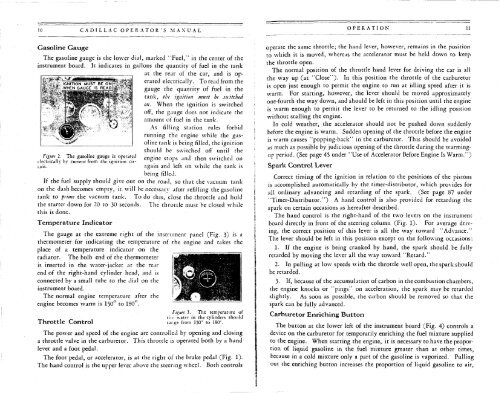1928 Cadillac - GM Heritage Center
1928 Cadillac - GM Heritage Center
1928 Cadillac - GM Heritage Center
You also want an ePaper? Increase the reach of your titles
YUMPU automatically turns print PDFs into web optimized ePapers that Google loves.
10 CADILLAC OPERATORS MANUAL<br />
OPERATION 11<br />
Gasoline Gauge<br />
The gasoline gauge is the lower dial, marked "Fuel," in the center of the<br />
instrument board. It indicates in gallons the quantity of fuel in the tank<br />
at the rear of the car, and is op-<br />
1 ^ : - ^<br />
erated electrically. To read from the<br />
gauge the quantity of fuel in the<br />
tank, the ignition must be switched<br />
on. When the ignition is switched<br />
off, the gauge does not indicate the<br />
amount of fuel in the tank.<br />
As filling station rules forbid<br />
running the engine while the gasoline<br />
tank is being filled, the ignition<br />
should be snitched off until the<br />
Figure 2. The gasoline gauge is operated engine stops and then switched on<br />
electrically by current from the ignition circuit.<br />
again and left on while the tank is<br />
being filled.<br />
If the fuel supply should give out on the road, so that the vacuum tankon<br />
the dash becomes empty, it. will be necessary after refilling the gasoline<br />
tank to prime the vacuum tank. To do this, close the throttle and hold<br />
the starter down for 20 to 30 seconds. The throttle must be closed while<br />
this is done.<br />
Temperature Indicator<br />
The gauge at the extreme right of the instrument panel (Fig. 3) is a<br />
thermometer for indicating the temperature of the engine and takes the<br />
place of a temperature indicator on the<br />
radiator. The bulb end of the thermometer<br />
is inserted in the water-jacket at the rear<br />
end of the right-hand cylinder head, and is<br />
connected by a small tube to the dial on the<br />
instrument board.<br />
The normal engine temperature after the<br />
engine becomes warm is 150 to ISO .<br />
Throttle Control<br />
Fipir- 3. The temperature of<br />
the water in the cylinders should<br />
rar.ge from 150° to 180'.<br />
The power and speed of the engine are controlled by opening and closing<br />
a throttle valve in the carburetor. This throttle is operated both by a hand<br />
lever and a foot pedal.<br />
The foot pedal, or accelerator, is at the right of the brake pedal (Fig. 1).<br />
The hand control is the upper lever above the steering wheel. Both controls<br />
operate the same throttle; the hand lever, however, remains in the position<br />
to which it is moved, whereas the accelerator must be held down to keep<br />
the throttle open.<br />
The normal position of the throttle hand lever for driving the car is all<br />
the way up (at "Close"). In this position the throttle of the carburetor<br />
is open just enough to permit the engine to run at idling speed after it is<br />
warm. For starting, however, the lever should be moved approximately<br />
one-fourth the way down, and should be left in this position until the engine<br />
is warm enough to permit the lever to be returned to the idling position<br />
without stalling the engine.<br />
In cold weather, the accelerator should not be pushed down suddenly<br />
before the engine is warm. Sudden opening of the throttle before the engine<br />
is warm causes "popping-back" in the carburetor. This should be avoided<br />
as much as possible by judicious opening of the throttle during the warmingup<br />
period. (See page 45 under "Use of Accelerator Before Engine Is Warm.")<br />
Spark Control Lever<br />
Correct timing of the ignition in relation to the positions of the pistons<br />
is accomplished automatically by the timer-distributor, which provides for<br />
all ordinary advancing and retarding of the spark. (See page 87 under<br />
"Timer-Distributor.") A hand control is also provided for retarding the<br />
spark on certain occasions as hereafter described.<br />
The hand control is the right-hand of the two levers on the instrument<br />
board directly in front of the steering column (Fig. 1). For average driving,<br />
the correct position of this lever is all the way toward "Advance."<br />
The lever should be left in this position except on the following occasions:<br />
1. If the engine is being cranked by hand, the spark should be fully<br />
retarded by moving the lever all the way toward "Retard."<br />
2. In pulling at low speeds with the throttle well open, the spark should<br />
be retarded.<br />
3- If, because of the accumulation of carbon in the combustion chambers,<br />
the engine knocks or "pings" on acceleration, the spark may be retarded<br />
slightly. As soon as possible, the carbon should be removed so that the<br />
spark can be fully advanced.<br />
Carburetor Enriching Button<br />
The button at the lower left of the instrument board (Fig. 4) controls a<br />
device on the carburetor for temporarily enriching the fuel mixture supplied<br />
to the engine. When starting the engine, it is necessary to have the proportion<br />
of liquid gasoline in the fuel mixture greater than at other times,<br />
because in a cold mixture only a part of the gasoline is vaporized. Pulling<br />
out the enriching button increases the proportion of liquid gasoline to air,
















